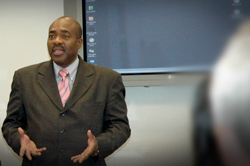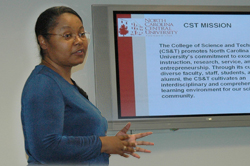July 29, 2008
Shepherd Project Goal: Recruiting Minority Graduate Students to the Sciences and CNSE
 |
|
Hayward Horton, associate dean of Graduate Studies, welcomed Shepherd Project participants. (Photo Karl Luntta) |
Horton, associate dean of Graduate Studies and professor of sociology, used that same theme in his welcome to invited faculty at the inaugural meeting of the Shepherd Project on July 23. "When we get your students, we're going to treat them right," he said.
Horton said a commitment to diversity in the math and science fields is a core priority, and he said "the focus is on faculty here connecting with other faculty." By building this community, the hope is that "you will send your best and brightest [students] to us."
The guests listening to Horton at the College of Nanoscale Science & Engineering (CNSE) were from three historically black colleges and universities: Norfolk State University, North Carolina State University, and Texas Southern University. CNSE professors Robert Geer and John Hartley outlined how UAlbany's CNSE offers students an unparalleled education, due in part to its unique partnerships with the world's leading nanotechnology firms.
Geer, CNSE vice president for Academic Affairs and professor of nanoscale science, gave an overview of the way in which CNSE puts the world within reach for its students.
"There are opportunities for students here that they will not have anywhere else," said Geer, adding that more than 2,000 scientists, researchers, engineers, students and faculty work onsite. CNSE is ranked #1 in the world by leading publication Small Times magazine for nanotechnology education.

|
|
Interim Dean of Science and Technology Saundra DeLauder of North Carolina Central University, a Shepherd Project participant. (Photo Karl Luntta) |
Hartley, professor of nanoengineering and expert in electron beam lithography, said one initial step in the Shepherd Project is to "see where our synergies lie." Toward that end, he offered to try and connect CNSE experts with the guests on particular areas of interest.
The visitors asked questions about summer internships for undergraduates (apply online and yes, they are paid internships); about the number of CNSE faculty (48 and growing); and about the mechanics of building public-private partnerships.
Hartley noted, "Years ago when I went to school, you only saw [representatives] from industry at career fairs." Today, at CNSE, students are "rubbing elbows on a daily basis" with their contacts in nanotechnology. "My students interact weekly if not daily with their colleagues in industry," said Hartley, director of the Advanced Lithography Center.
The visitors also heard from UAlbany Assistant Dean of Graduate Studies Betty Shadrick, who explained the benefits of the Alliance for Graduate Education and the Professoriate (AGEP) program.
![]() For more news, subscribe to UAlbany's RSS headline feeds
For more news, subscribe to UAlbany's RSS headline feeds




